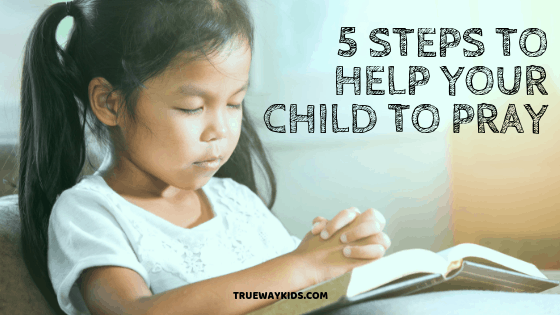We all struggle in the area of prayer. How then do we teach our children to pray? Maybe you really want to teach your child or grandchild to pray but are feeling inadequate.
Fortunately, children can learn to pray faster and easier than adults, as they don’t overcomplicate it.
Jesus said, “Let the little children come to me, and do not hinder them, for the kingdom of heaven belongs to such as these.” Matthew 19:14 NIV
“At that time the disciples came to Jesus and asked, ‘Who, then, is the greatest in the kingdom of heaven?’He called a little child to him and placed the child among them. And he said: ‘Truly I tell you, unless you change and become like little children, you will never enter the kingdom of heaven. Therefore, whoever takes the lowly position of this child is the greatest in the kingdom of heaven. And whoever welcomes one such child in my name welcomes me.’”Matthew 18:1-5 NIV
Here are Five Steps to Help Your Child Pray
1. Model Prayer
Learning any new skill begins with the student watching the teacher. There are several ways you can model prayer to your children and help your child to pray.
Words
Speak your prayers out loud when your little one is near. Demonstrate both short and long prayers. Model routine prayer, such as grace, and spontaneous prayer, like when someone becomes ill and even when you’re in a rush.
Silent prayer
It is also important to model silent prayer. Tell your toddler you need to speak to Jesus for a few minutes and then be silent. If your toddler interrupts, treat it like he was interrupting two adults speaking. “Excuse me, my love, but God and I are talking right now, and I will be done in a moment.”
Songs
Many children’s bible songs or simple worship songs are prayers. Have worship music playing in your home. Encourage your toddler to sing along and remind them often that Jesus hears them singing. Let your little one know that Father God sings over them.
The Lord your God is with you, the Mighty Warrior who saves. He will take great delight in you; in his love he will no longer rebuke you but will rejoice over you with singing.” Zephaniah 3:17 NIV
Prayer is Powerful
Model for your child that you believe in prayer. When someone is sick, something is lost, or there is bad news, show your child that the first place you go is to God.
Rejoice always, pray continually, give thanks in all circumstances; for this is God’s will for you in Christ Jesus.- 1 Thessalonians 5:16-18 NIV
Start Early
You can begin teaching your child to pray in the womb. Speaking your prayers out loud during pregnancy teaches your child the repetition and cadence of prayer. After birth, pray while you feed them or rock them. When they get older, teach them to fold their hands and wait for Daddy to pray blessings before eating.

2. Create Expectation
Just modelling prayer will not make it a habit for your child. You will need to allow prayer to become a part of his everyday life if you really want to help your child to pray.
Times
It is important for a child to begin to expect prayer at specific times. Morning, meals, bedtime, and on Sundays are great times to create a routine around prayer or during a weekly family devotion.
Situations
Teach your toddler to pray outside of the routine when necessary. You might stop an activity and ask your toddler to pray with you when there is new information, good or bad. You might ask that they ask for forgiveness if they have misbehaved. You could ask them to pray for another child who is in distress.
“Let us then with confidence draw near to the throne of grace, that we may receive mercy and find grace to help in time of need.” Hebrews 4:15-16 NIV
Read books on prayer
This is a great time for you to learn more about prayer yourself. Read some books on prayer, teaching prayer, and deepening your prayer life.
Record answered prayers
Create a book for your family, where you record prayers and answered prayers. Demonstrate God’s goodness by recognising and celebrating answered prayers. Another creative task is a prayer journal. Have a book next to your child’s bed. Record specific prayer requests in the journal take time every month or couple months to go back and review the lists. If prayer was answered, you could record it.

3. Repetition
Before your child can learn to create their own prayers, they will need to copy you. You can do this by asking your child to repeat your words or have a specific prayer for grace.
Lord’s prayer
The Lord’s Prayer is a great bedtime prayer. You can have your child repeat the prayer word for word and slowly memorise, or you can speak one line and have them say it in their own words.
Songs
Children learn songs often before they learn to speak sentences. Teaching short, simple, biblical songs can be a great way to help your child to pray with independence.

4. Prompting Prayer
Give your child prompts for when to pray.
Request Prayers
Encourage your child to put requests in their prayers. If your child would like a new bike, encourage them to pray for that item. If your child is scared about something, pray with them about that.
Thank-You Prayers
Instruct your child to say thank you for the things and people that are important. This can be a list in their prayer journal, or you can remind them.
Grace
Grace can be a rote prayer that you ask your child to pray at each meal. It can also be a purposeful prayer such as saying thanks for blessings.
Bedtime Prayers
Bedtime can be a great time to guide your toddler through prayer. You can prompt them to say what they are thankful for, state how they feel about Jesus, or ask for help with something. Allow them to be creative and do not put limits on their expression.
Situational Prayers
If your toddler becomes aware of a tragedy, illness, or family event, such as an upcoming birth, coach them how they can pray specifically for the event.
Forgiveness Prayers
When your child misbehaves, create time for them to pray and ask for forgiveness and ask for help to be obedient. This could be prayers to ask Jesus to teach them how to share, help to obey, or to be kind.

5. Creative Expression
Once you have taught your toddler when, how, and what to pray, the next phase of learning is to encourage their independence.
It’s a Conversation
The next step is to move beyond rote and expected prayers to spontaneous expressions of prayer. Discuss with your toddler that he can talk to Jesus like he talks to you or a friend.
Age Appropriate
Allow for age-appropriate involvement. You may start with assisting them in folding their hands and closing their eyes and gradually moving towards speaking prayer. Children will often pray much freer and naturally than adults.
Creative expression.
This is not the time to correct for form and substance. Let your little one create their own prayer language with God. The Holy Spirit takes all prayer and relays it to Father God, so trust He will hear and understand even if it is not polished.
“In the same way, the Spirit helps us in our weakness. We do not know what we ought to pray for, but the Spirit himself intercedes for us through wordless groans.” Romans 8:26 NIV
Maybe your child would like to paint a picture regarding a prayer. Allow them to speak to God in their own way.
Suggestions
If you are looking for prayer suggestions, you can use the Lord’s Prayer, the apostolic prayers from the New Testament, and the Psalms, using a child’s version will keep the language age appropriate.

Resources to Help Your Child Pray
- https://www.lifewithmylittles.com/how-to-teach-your-child-to-pray/
- https://www.learnreligions.com/teaching-children-to-pray-700148
- https://www.focusonthefamily.com/parenting/babies-toddlers-preschoolers/prayer-time/pray-with-young-children
- https://www.focusonthefamily.com/parenting/spiritual-growth-for-kids/talking-to-god/the-gift-of-prayer-ask-seek-knock?utm_source=FOTF&utm_medium=referral&utm_campaign=ParentingJSON
- https://www.focusonthefamily.com/parenting/spiritual-growth-for-kids/talking-to-god/teaching-kids-to-pray


